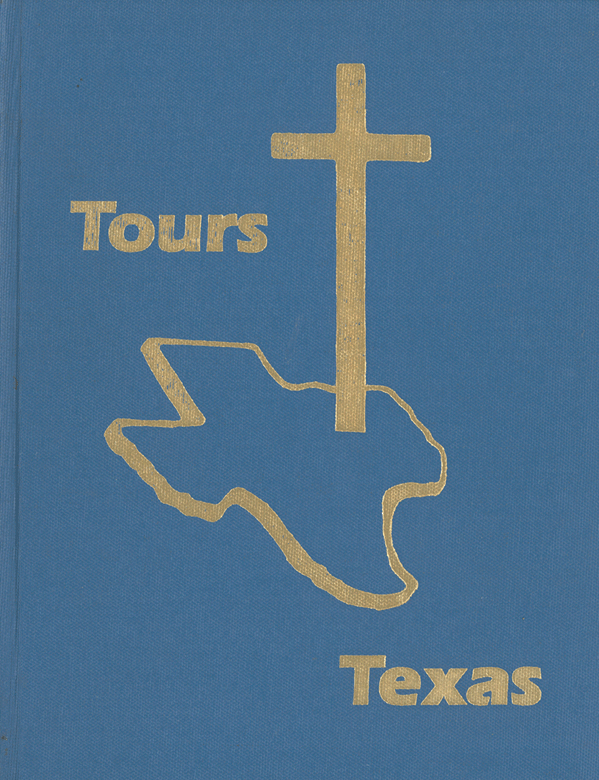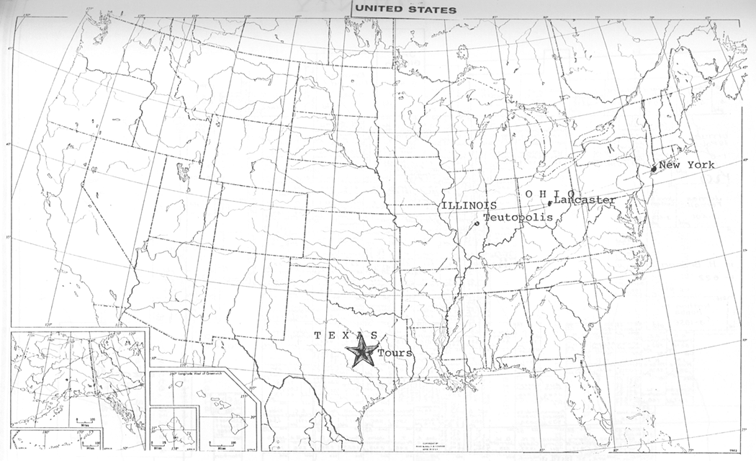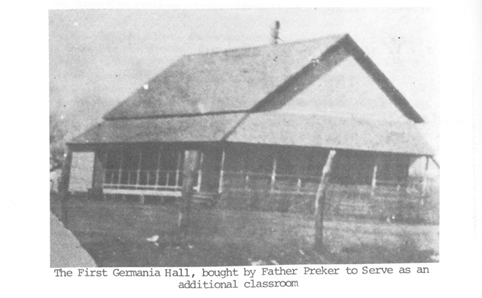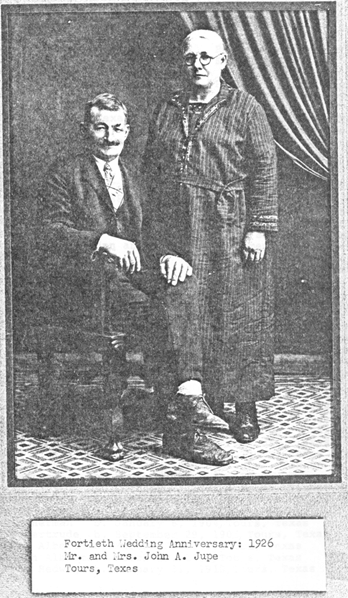
Texas Small Town History Project Palo Alto College |
|
Jessica Waneck History 1302 |
Robert Hines November 14, 2006 |
Tours, Texas
|
|

Origins: The first settlers of the town of Tours did not come seeking religious freedom. They were not looking for democracy or fleeing from political turmoil or instability. Nor were these families poor. This group of settlers has already spent many years in the United States. Many have been born in America, were skilled craftsmen and had comfortable lives in Illinois in very civilized surroundings. What was so inviting for these first settlers who gave up so much to settle in a remote part of Texas? In 1873, some residents of Teutopolis, Illinois( click here to learn more about Teutopolis) made the decision to more to Texas. This decision was not made spur of the moment. The group had given this a great deal of thought and discussion. Texas! Texas had been calling to them for quite some time. Agencies had been set up to promote Texas and recruit settlers. Texas was full or promise and fortune, prospective settlers were told. They described a very pretty picture with maps and brochures. Texas offered what these families wanted – large amounts of cheap land. A place in Texas called to these settlers. They were most interested in the University lands in Northeast McLennan County. For $288.00 plus 10% interest, a family could buy 160 acres. And there was plenty of land available. The group making the trip were experienced. Some had emigrated to the U.S. from Europe and had found success in America. However, they believed more opportunity existed in Texas and they were ready for it.
Jupe, Sister Mary Elizabeth. A History of Tours, Texas. San Antonio, Texas: 410 Printing Center, 1988 West News, 1965
Jupe, Sister Mary Elizabeth. A History of Tours, Texas. San Antonio, Texas: 410 Printing Center, 1988 Jupe, Sister Mary Elizabeth. The Jupe Family Heritage Book. San Antonio, Texas: Our Lady of the Lake University, 1982.
Landmarks: The most important landmark in Tours would have to be St. Martinsville Church. For pictures of the church, click here. Historical Marker in Tours Community
Erected in 1980 Journey to Tours: For about a year, the group prepared for the journey. They sold their property, cancelled leases and generally prepared for the trip and their new lives. It was estimated that the trip would take 60 days. They packed what they needed for the trip in covered wagons. These travelers were very devoted Catholics and they brought their religion with them on this journey. The wagon train left Teutopolis, Illinois on October 3, 1874. The group gathered early in the morning with friends and family for a Mass. The priest blessed the travelers and the wagon train and everyone said goodbye. The journey began!
It was a difficult trip. The men and children usually walked to lighten the wagons for the mules pulling the heavy wagons. They took the stage coach road to St. Louis and were ferried across the Mississippi River. The wagon train moved southwest, but the way became more difficult. The Ozark Mountains were very hard to cross and took a toll on the travelers.
This trip was tiresome. After traveling all day, usually on foot, the wagon train tried to camp by a stream. The men took care of the animals while the women milked the cows and prepared the meal. Water containers were refilled and everyone got ready for sleep. On Friday evenings it was very important that they camp near water. They did not travel on Saturday and Sunday. Saturday was spent baking bread, making repairs, washing and bathing. Sunday was spent resting. Everyday the group prayed the rosary, and Sundays were quiet, reflective days. It is certain that both the animals and the humans needed this day of rest per week. While on the trip, Emilia Dulock went into labor. The baby was due in late November but probably due to the hardship and stress of the trip the baby came early. The group stayed with the Dulocks for the weekend but then moved on without them. The Dulocks planned to meet the group in McLennan County.
Oklahoma was called Indian Territory at this time and was the most dangerous part of the trip. The wagon train had to camp in a large circle with a large fire in the middle. The fire was kept burning all night and the men took turns standing watch. The livestock – cows, mules, and horses – were tied in the middle of the circle to protect them. Indians were always around, sometimes only a few but at times there could be hundreds. Finally, the group reached McLennan County. On land between Rice Creek and Elmfork Creek, the travelers had reached the end of their journey. It was on November 11, 1973, the feast day of St. Martin, Bishop of Tours, France that the weary travelers reached their destination.(To learn more about St.Martin click here) They named their settlement St. Martinsville in his honor. They were home! But it was far from a comfortable home. It was all wilderness and prairie. Water was close by but there were no roads, stores or homes. Any civilization was at least a day’s journey away. Jupe, Sister Mary Elizabeth. A History of Tours, Texas. San Antonio, Texas: 410 Printing Center, 1988 Goldmark, Josephine. Pilgrims of 48. New York, New York: Arno Press, 1975 Benjamin, Gilbert Giddings. The Germans in Texas, A Study in Immigration. San
Francisco, California: R and E Research Associated, 1970.
Building a Town:The first winter the families lived in the wagons but the animals had to live in the elements. Rustlers roamed the area and stole many of the animals the settlers had so carefully brought with them from Illinois. The first Christmas in Texas was very different from the delightful celebrations they had enjoyed in Illinois. There was no candy, fruit, toys or even a tree. The children believed that Santa was unable to find them in this isolated wilderness.
Jupe, Sister Mary Elizabeth. A History of Tours, Texas. San Antonio, Texas: 410 Printing Center, 1988 Biesele, Rudolph Leopold. The History of German Settlements in Texas, 1831-1861. Austin, Texas: Von Boeckmann Company, 1930
Jupe, Sister Mary Elizabeth. A History of Tours, Texas. San Antonio, Texas: 410 Printing Center, 1988 Benjamin, Gilbert Giddings. The Germans in Texas, A Study in Immigration. San
Francisco, California: R and E Research Associated, 1970.
Over the next few years, other settlers came to make St. Martinsville their home. In the fall of 1875, other settlers came from Teutopolis. Others came from Europe traveling through the ports at Baltimore and Galveston and traveling by wagon to central Texas. Usually these settlers were relatives of the people already in Texas.
Do you remember the Dulock family? They had been left behind when a baby was born. They resumed their journey as soon a Emilia was able to travel, following the Old Chisholm Trail looking for their group. (Learn more about Old Chisholm Trail)They never found them and instead found themselves in another community of German settlers in Seguin. They stayed there about a year but did not find the area to their liking. The decided to move back to Illinois. On the trip they stopped in Waco and heard about a settlement nearby populated by people with familiar names. They were excited to join their friends and settled in St. Martinsville. Jupe, Sister Mary Elizabeth. A History of Tours, Texas. San Antonio, Texas: 410 Printing Center, 1988 Goldmark, Josephine. Pilgrims of 48. New York, New York: Arno Press, 1975.
Jupe, Sister Mary Elizabeth. A History of Tours, Texas. San Antonio, Texas: 410 Printing Center, 1988 Goldmark, Josephine. Pilgrims of 48. New York, New York: Arno Press, 1975.
Jupe, Sister Mary Elizabeth. A History of Tours, Texas. San Antonio, Texas: 410 Printing Center, 1988 Benjamin, Gilbert Giddings. The Germans in Texas, A Study in Immigration. San
Francisco, California: R and E Research Associated, 1970.
Jupe, Sister Mary Elizabeth. A History of Tours, Texas. San Antonio, Texas: 410 Printing Center, 1988
One of the needs of the community was for coffins. Andrew Holecek became the main source for much needed coffins. He built them by hand. The coffins were sturdy and functional and it didn’t matter if they were not beautiful.
Holecek died in February of 1919 of stomach cancer. His second wife, Katherine ran the store for twelve years. Gradually she turned the operation of the store over to her children. At some point, her son Andrew Jr. took over the operation of the store as the sole owner.
The early settlers knew there was a big part of their settlement missing because they had no school. In the third group of settlers was finally a teacher. Heinrich Hattrup was a graduate of the Franciscan College in Quincy, Illinois. Hattrup was a dedicated teacher operating in primitive conditions. He taught all grades and on Sundays taught religion too. He lived with the families whose children he taught as part of his salary. This was the beginning of the Tours school. The area had several different teachers, some who were good and some who were not. Finally, in 1890, the parish built a school and three sisters from the Sisters of Divine Providence in San Antonio came to staff St. Martin’s School. (Learn more about the Sisters of Divine Providence) Like many villages, Tours had a saloon or beer joint. Charles Smajstria is believed to have built and operated this beer joint. Later, Joe Prasifka operated the store as a café and bar until it became illegal to sell alcoholic beverages in 1919.
There didn’t seem to be much need for law enforcement at the beginning of Tours. As the town grew, it seemed that at dances were the only times disputes occurred. Drinking was popular among the Germans at social events. By 1890 a constable was in place in Tours.
When the eighteenth amendment was passed in 1919, it became illegal to sale alcoholic beverages.(Learn more about the 18th amendment) This was called prohibition. Prohibition was an impractical law because alcoholic beverages could be brewed by individuals from many farm crops. Bootlegging – the illegal sale of alcoholic beverages – was a big industry in McLennan County. Along the Elm Creek bottoms it was very popular and profitable to brew moonshine. In the area, more than fifty stills brewed five hundred gallons of moonshine a week. It was easy to see how this area became known as “Whiskey Hollow.” Many bootleggers made a great deal of money selling moonshine. Some of the whiskey was sold locally but much of it was shipped to Waco, Dallas and Fort Worth.
Bootlegging was not without its problems. Sometimes the whiskey would turn blue and had to be filtered through a felt hat or chamois cloth. Highjackers often would steal from the bootleggers. But federal agents were a more serious problem. These federal agents would arrest the bootleggers and destroy the stills. Some of the bootleggers who were arrested served time in the federal penitentiary.
Bootlegging ended with the repeal of the eighteenth amendment. This was a very strange time in American history. Law-abiding citizens broke the law to protest what they believed to be an unjust law and made a lot of money as well. Jupe, Sister Mary Elizabeth. A History of Tours, Texas. San Antonio, Texas: 410 Printing Center, 1988 Handbook of Waco, 1960 Handbook of McLennan County, 1965 Jupe, Sister Mary Elizabeth. The Jupe Family Heritage Book. San Antonio, Texas: Our
Lady of the Lake University, 1982.
Jupe, Sister Mary Elizabeth. A History of Tours, Texas. San Antonio, Texas: 410 Printing Center, 1988
Jupe, Sister Mary Elizabeth. A History of Tours, Texas. San Antonio, Texas: 410 Printing Center, 1988 Jupe, Sister Mary Elizabeth. The Jupe Family Heritage Book. San Antonio, Texas: Our
Lady of the Lake University, 1982.
Interviews:Not too many people can say the pharse "I wrote the book on that," and it actually mean they wrote an actual book on it. While in the case of my great-aunt Sister Mary Elizabeth Jupe, she did write the book on Tours, Texas. It can be found in the San Antonio Public Liberay, and even the Texas Handbook Online uses her book for their information. To read the interview I had with Sister Mary Elizabeth,click here. Jupe, Sister Mary Elizabeth. Personal Interview, October 1, 2006
Photos: To view more pictures,click here. Links: Texas Handbook Online: Tours, Texas Bibliography
Benjamin, Gilbert Giddings. The Germans in Texas, A Study in Immigration. San
Francisco, California: R and E Research Associated, 1970.
This book gave me information about immigration in general and the Germans in particular. It was a very helpful book.
Biesele, Rudolph Leopold. The History of German Settlements in Texas, 1831-1861.
Austin, Texas: Von Boeckmann Company, 1930
This book gave me much information into the German Settlements in Texas and the culture they formed. It was very interesting to realize how much the German culture shaped and formed who we are today. Central Texas Genealogical Society, Inc.: St. Martin’s Cemetery.
I got information about the families and ideas about when they lived and died. It was a great foundation. Geue, Chester William and Ethel Handler Geue. A New Land Beckoned. Waco, Texas:
Texian Press, 1972
This book helped me understand the draw that Texas was to these pioneers. Geue, Ethel Handler. New Homes in a New Land. Waco, Texas: Texian Press, 1970
This book helped me understand the progression of different types of homes that the settlers built. As the settlers became used to their new land their houses and building methods changed. Goldmark, Josephine. Pilgrims of 48. New York, New York: Arno Press, 1975.
This was a general information book. General Land Office, Austin, Texas
The information at the General Land Office was very helpful. Here are the complete record of all the land grants that was part of my report. Jordan, Terry G. German Seed in Texas Soil. Austin, Texas: University of Texas Press, 1966
This book was of general information but a very broad look and it was not too specific to my paper.
Jupe, Sister Mary Elizabeth. A History of Tours, Texas. San Antonio, Texas: 410 Printing
Center, 1988
This was an extremely important book to my report. It formed the basis and much of the information I needed.
Jupe, Sister Mary Elizabeth. The Jupe Family Heritage Book. San Antonio, Texas: Our
Lady of the Lake University, 1982.
The Jupe Family was one of the original founding families in Tours. This book gave a different view of life in Tours, Texas and insight into a family’s journey with Tours.
Jupe, Sister Mary Elizabeth. Personal Interview, October 1, 2006
Sister Mary Elizabeth is the person responsible for my choosing Tours as the town for my paper. She is the author of several books and is a wealth of information and guidance. Her interview and encouragement were so valuable to me. I am proud and lucky that she is my great-aunt.
Handbook of Waco, 1960
This handbook gave me an overview of the history of the Waco area.
Handbook of McLennan County, 1965
This handbook gave me an overview of the history of McLennan County.
Handbook of Texas Online, s.v.
http://www.tsha.uteas,edu/handbook/online/articles/TT/hlt25.html (accessed November 6, 2006).
This was a very short article but it contained a lot of information.
Historical Marker in Tours Community
Erected in 1980
This marker reinforced information I received other places and help me understand how this town was settled.
Texas Almanac, 1873
The Almanac contains information about the way of life of the people in Texas in 1873. It is very interesting and informative.
Texas Almanac, 1879
The Almanac contains information about the way of life of the people in Texas in 1879. It is very interesting and informative.
United States 1880 Census, Tours, Texas
The census lists all residents of Tours, who live together, their ages and occupations. It told me who was living in Tours at this time.
United States 1890 Census, Tours, Texas
The census lists all residents of Tours, who live together, their ages and occupations. It told me who was living in Tours at this time.
West News, 1965
This was an anniversary addition that contained many interesting historical articles.


